Wisconsin is renowned for its diverse and plentiful mushroom population. Home to over 100 species of mushrooms, this state offers an incredible range of fungi that can be found in many different habitats.
From edible varieties like chanterelle and porcini to brightly colored species like amethyst deceivers, the mushroom population is vast.
Each species has its own characteristics, habitats, and uses, making them fascinating to explore. For mushroom enthusiasts looking for an adventure, the article below will help you identify different mushrooms of Wisconsin.
List of Mushrooms of Wisconsin
1. Trametes Versicolor (Turkey Tail)
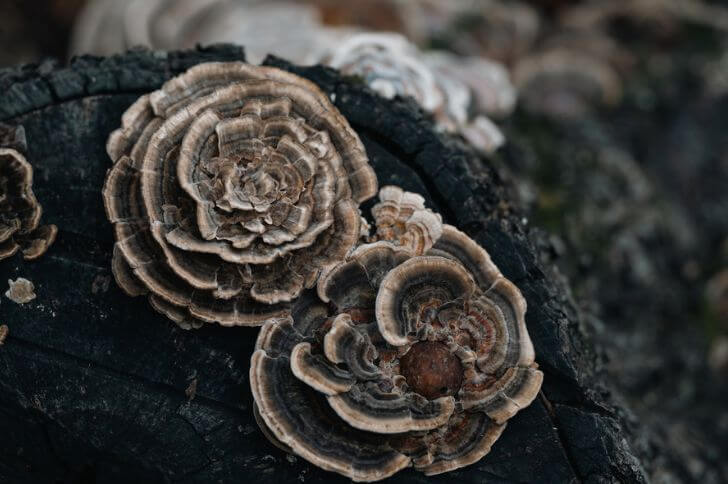
Turkey tail is one of the most common polypore in the West and Wisconsin is no exception. It comes in various colors but there are some key telltale signs to help distinguish from its lookalikes.
Identification:
Its scientific name “versicolor” refers to the fact that it can be found in a variety of colors. Three surefire ways to identify turkey tails include:
One, check the shape of the cap. Trametes versicolor have fan-shaped caps with wavy margins. Also note the caps have zones with different colors. If its only grayish, that is a lookalike.
Two, touch the cap and feel its texture. If it is velvety, you have a turkey tail.
Three, using a magnifying glass, check its pore surface. Turkey tails have visible pores that are whitish in young polypores and grayish in older fungi. They have no distinctive smell.
Trametes versicolor grows on dead hardwood trees.Their thick, leathery flesh can be dried and used in smoothies and teas.
2. Lycogala Epidendrum (Wolf’s Milk)
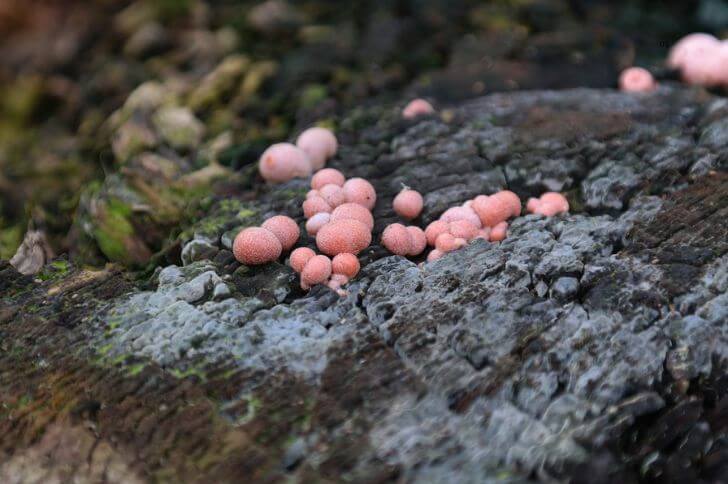
Lycogala epidendrum, also known as Wolf’s Milk, is a small species of jelly-like fungus that is also found in WI.
Identification:
This slime mold typically appears as small pinkish balls. They grow gregariously on large dead logs. When popped, they produce an orangish paste.
When can you find wolf’s milk? They appear between June and November. Their fruiting body is less than an inch wide.
3. Chanterelles
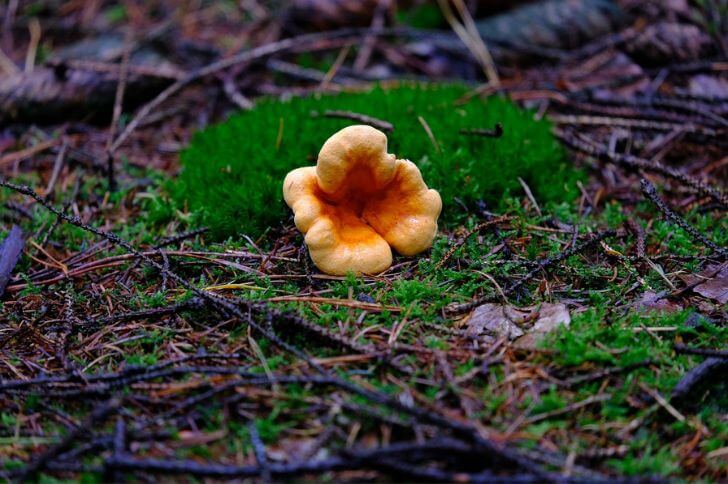
Chanterelles are another wonderful mushroom of Wisconsin. There are two main types found within the state.
Golden Chanterelles: These mushrooms grow in the summer and fall in hardwood forests throughout Wisconsin.
Golden chanterelles have a bright yellow color with ruffled caps that give them an almost flower-like appearance. They are non-gilled mushrooms but have false gills under the funnel-like cap.
Golden chanterelles offer an earthy sweetness paired with a subtle nuttiness that has been described as combining apricots with almonds.
Red chanterelles: This mushroom stands apart from other mushrooms with its bright red color and funnel-shaped cap.
The Cinnabar Chanterelle grows in both coniferous and deciduous forest habitats in moist environments, often near rotting wood or moss.
With its unique coloration, experienced mushroom collectors can easily identify this species when foraging.
4. Oysters
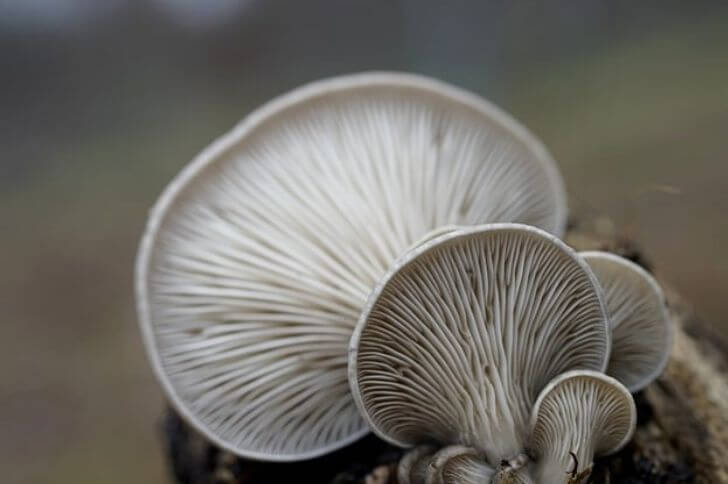
Like chanterelles, there are three main types of oysters found in the Badger State wild. But note, other uncommon oyster varieties can be cultivated.
Golden oysters: Pleurotus citrinopileatus, you may know it as the golden oysters, is an edible mushroom species with a distinct yellow coloration that differs in shape from other oyster mushrooms.
This edible Wisconsin fungus is characterized by its bright yellow cap which may reach up to 4 inches in diameter when fully mature.
Its stem is typically whitish in color, slightly thicker at the base than towards the top. The gills of this mushroom are white or almost white in color, while the spore print will be pale lilac.
Aspen oyster: Identified by their whitish to light tan broad, fan-shaped caps, aspen oyster mushrooms are easily recognizable.
Their caps can grow up to 10 inches in diameter with thick decurrent gills attached to the underside where spores form. Hunt for these mushrooms of Wisconsin in summer and fall.
Olive oysterling: Scientifically known as Sarcomyxa serotina, olive oysterling mushrooms are rare. With a unique appearance and delicious flavor, they have become increasingly popular.
5. Ischnoderma resinosum (Resinous Polypore)
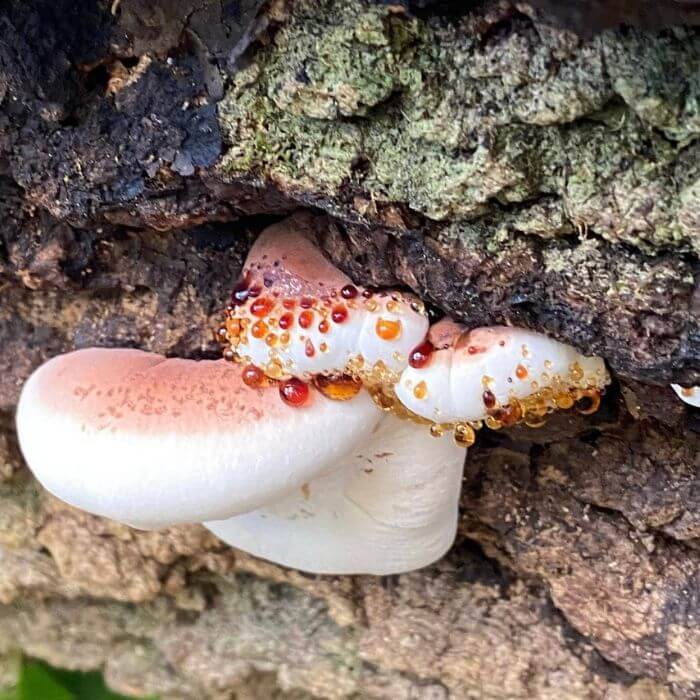
source: shawnhallart
There are a variety of polypores that grow in Wisconsin. The resinous polypore, also called late fall polypore, is a common bracket fungus in this part of the world.
Identification:
It is a white rot fungus that decays dead wood and provides essential organic matter to the surrounding environment.
Its fruiting body is easy to identify. Resinous polypore size varies from 1.9-7.5 inches. The cap is also thick, growing to 3.5 inches thick. Like the turkey tail above, its surface has zones of different colors ranging from pinkish brown to light brown to dark brown.
They do not have stems. It often forms shelves on logs or stumps where it can spread out over several inches allowing for easy identification.
6. Leucopaxillus Albissimus
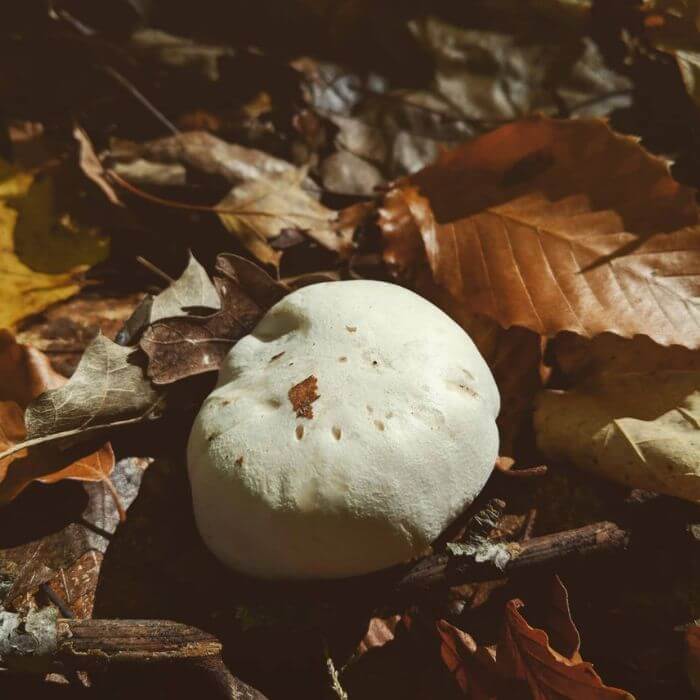
source: code_name_meg
Leucopaxillus albissimus are inedible. As a mushroomer, identifying this WI fungus will help you avoid it.
Identification:
These mushrooms of Wisconsin, like the polypores above, are saprobics. They help in decomposing dead matter. You can spot them in fairly rings or in tight groups. They have convex caps with inrolled margins that grow to 5 inches.
Young leucopaxillus albissimus are whitish with velvety texture while older species are bald and tan. When sliced its white flesh should not change color. Note its slightly fibrillose stem.
7. Morels (Morchella)
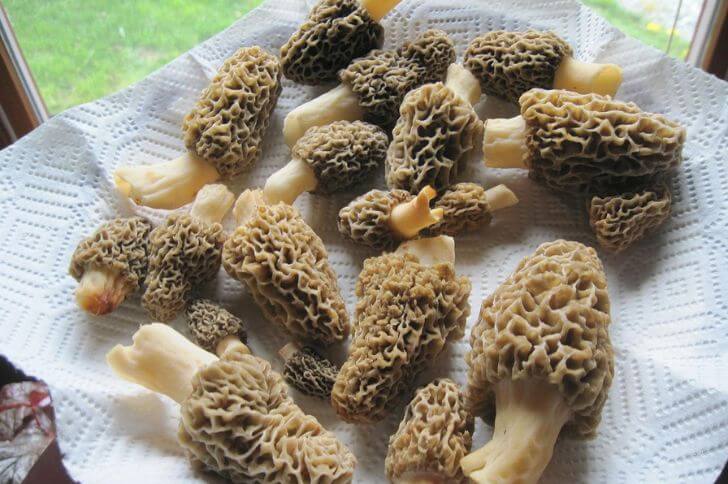
What month do morels come up in Wisconsin? They pop in March lasting through May. And there are several Morchella varieties found in the Badger state.
Morchella punctipes: Commonly called the half-free morels, this edible mushroom in Wisconsin is a member of the Morchellaceae family.
It has a distinctively wrinkled cap with ridges in shades of yellow or tan. Its stem is hollow and usually longer than other species in the morel family. You can find it from March to May.
Morchella americana: Found during the spring months, these mushrooms are most often identifiable by their distinctive spongy-looking cap and unique honeycomb-like pattern.
With a hollow stem and light tan to brownish yellow caps, these mushrooms can be identified by even novice foragers.
Morchella americana can be found near hardwoods such as ash and elm trees or around dead or decaying vegetation on the forest floor.
Morchella esculentoides: Also known as the yellow morels, this variety of morels has a distinctive yellow to tan color, with pits and ridges that are characteristic of most morel mushrooms. It typically grows from late March to June in areas where there is ample moisture.
8. Fomes Fomentarius (Hoof Fungus)
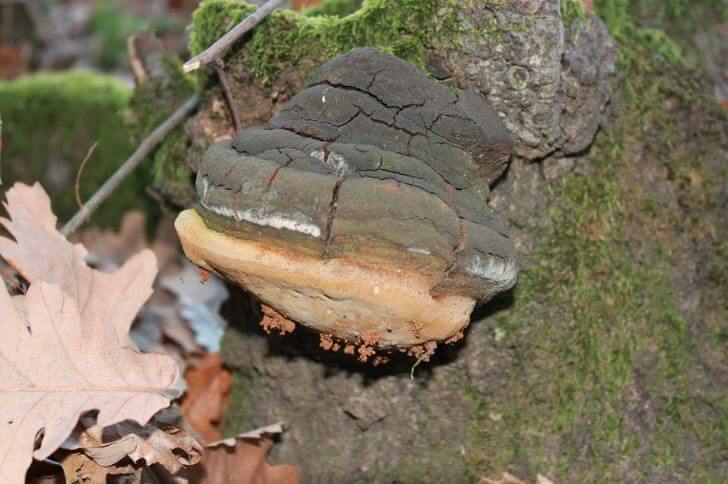
Fomes fomentarius is a shelf fungus with many names. You may know it as ice man fungus, tinder conk or hoof fungus.
Identification:
This bracket fungus grows on beech and birches. It has a distinctive hoof-like shape and can range in color from gray to brown. The upper part of this mushroom is zoned. They grow singly or in small groups. Note its fruity smell.
Can you eat hoof fungus? No, it’s too hard to eat. However, this fungus and its flesh has been used to make caps, gloves and more. It’s also used in fly fishing.
9. Armillaria Mellea (Honeys)
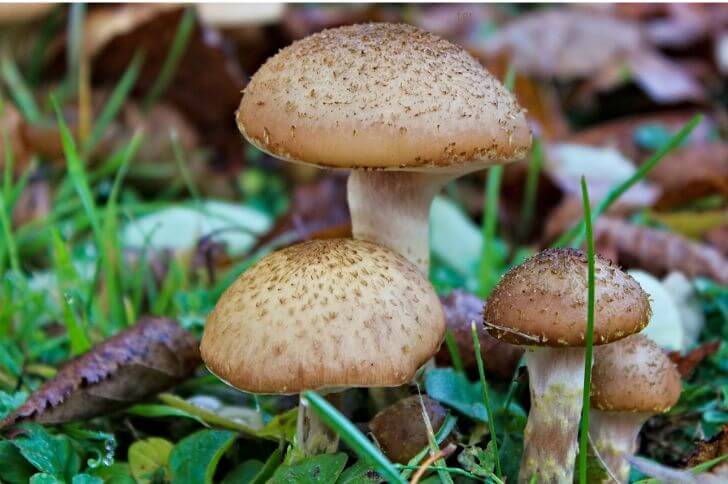
Honeys are common in the West. Scientifically called armillaria mellea, these clustered mushrooms of Wisconsin are easy to identify.
Identification:
This particular mushroom is identified by its thick, yellow-brown caps with whitish-yellow gills and creamy white spores.
Its caps have sticky surfaces that become slimy when wet. It usually grows in clusters on tree stumps or roots during the late summer and fall months.
What do honeys smell like? They have a strong mushroomy smell when young. I like them sauteed.
10. Calvatia Gigantea (Giant Puffball)
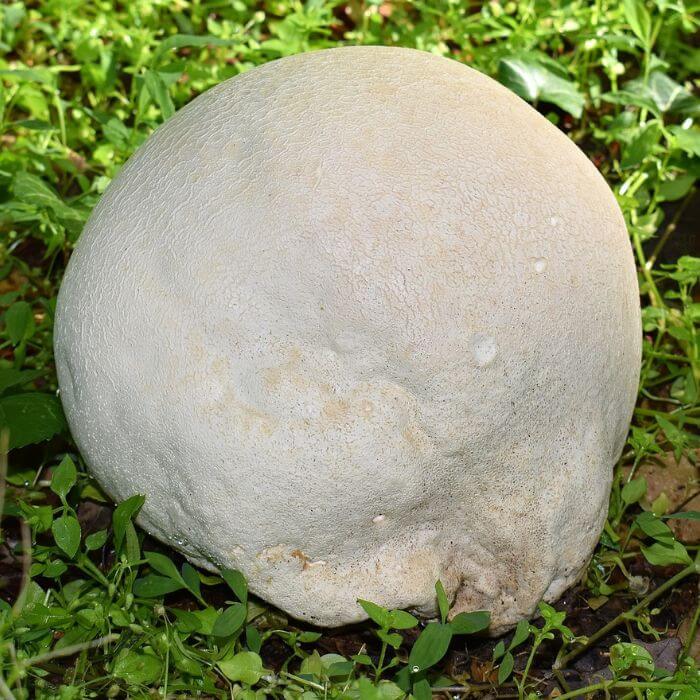
There is no way you can miss a giant puffball; even as a novice forager. Its the kind of Wisconsin mushroom that is too large to miss.
Identification:
They are typically found in pastures and open woodlands from summer to early fall. These mushrooms are characterized by their large white almost spherical appearance.
They can get pretty large. A giant puffball weighing 50 pounds has been reported—making it one of the largest mushrooms that grow on land. From afar, its fruiting body looks like an abandoned ball.
The exterior of these puffballs is a smooth white color and they will darken with age. As they age, they will eventually turn brown and become soft and spongy to the touch. Sliced open, young species have all white flesh that doesn’t change.
How do you prepare this white Wisconsin mushroom? Cut it in half and check if it is infested. Peel off the skin and cube the white flesh. It does not have a particular taste. It borrows the flavor of ingredients around it.
11. Ramaria Stricta
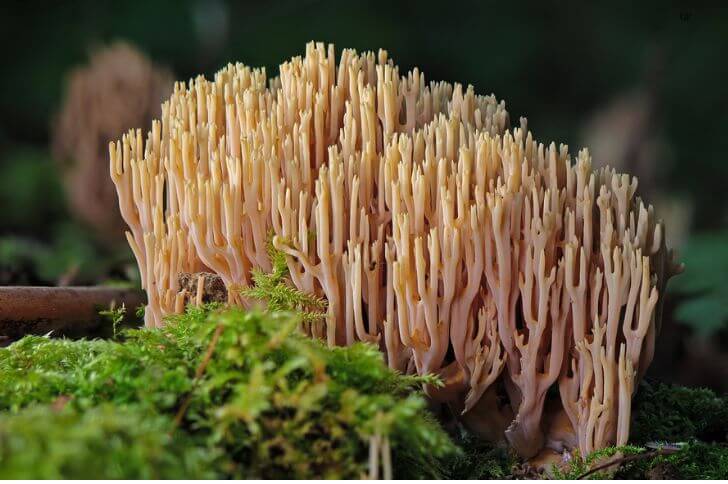
Are there coral mushrooms in Wisconsin? Ramaria stricta, commonly referred to as the “strict-branch coral,” is a coral mushroom of Wisconsin.
Identification:
It is easily identifiable by its thin and yellow-tinted branches that form an intricate branching pattern. The top of each branch has a characteristic rounded or pointed tip. The entire structure can range in color from white to buff. Additionally, it bruises purplish brown.
These corals have a faint sweet odor and are considered inedible.
12. Lactarius Indigo (Indigo milk cap)
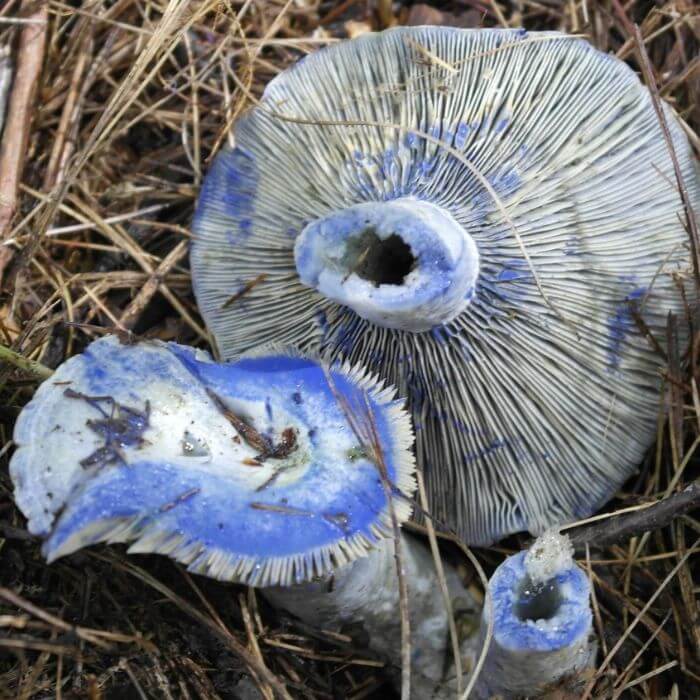
source: natura_ontariana
Lactarius indigo, colloquially referred to as the blue milk mushroom or Indigo Milk Cap mushroom, is unique and doesn’t have any close lookalikes.
Identification:
With its distinct deep blue coloring, it is often sought after by mushroom hunters. Identification of this species is not difficult if you know what to look for.
The most distinguishing characteristic of Lactarius indigo is its deep blue coloration. From top to bottom the mushroom typically appears dark blue-purple with an off-white center. The texture is usually dry and brittle to the touch; however some specimens may have a slimy texture near the base due to rain or humidity.
When sliced, the lactarius indigo has white flesh. Exposed to air, the whitish flesh changes color to dark green. Note like other milkys, they produce a (bluish) milky liquid when cut.
Where can you find these milk caps in Wisconsin? Check on the ground in coniferous forests.
13. Laccaria Ochropurpurea (Purple-gilled Laccaria)
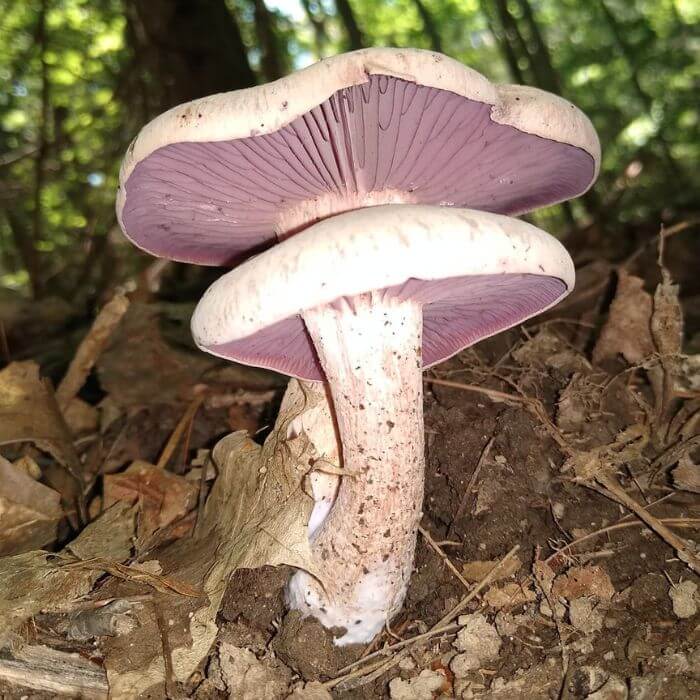
source: jovans_pictures
Common in late summer and fall, laccaria ochropurpurea is a broadly convex mushroom that belongs to the Laccaria genus.
Identification:
It is one of the most beautiful fungus in Wisconsin. Its other name is purple-gilled laccaria.
This mushroom has four main characteristics which make it easy to identify: its cap color ranges from white-pinkish to dark purple; it has a broad convex shape that in due course flattens with age; its gills are thickly attached
The size of this mushroom varies from 1.7 inches wide when young to 7.5 inches wide when fully grown, with a white spore print with no distinctive smell.
Purple-gilled laccaria are edible. However, they’ll lose their gorgeous hue when cooked. Also, their taste doesn’t stand out compared to other mushrooms of Wisconsin like morels.
14. Retiboletus Ornatipes (Ornate-stalked Bolete)
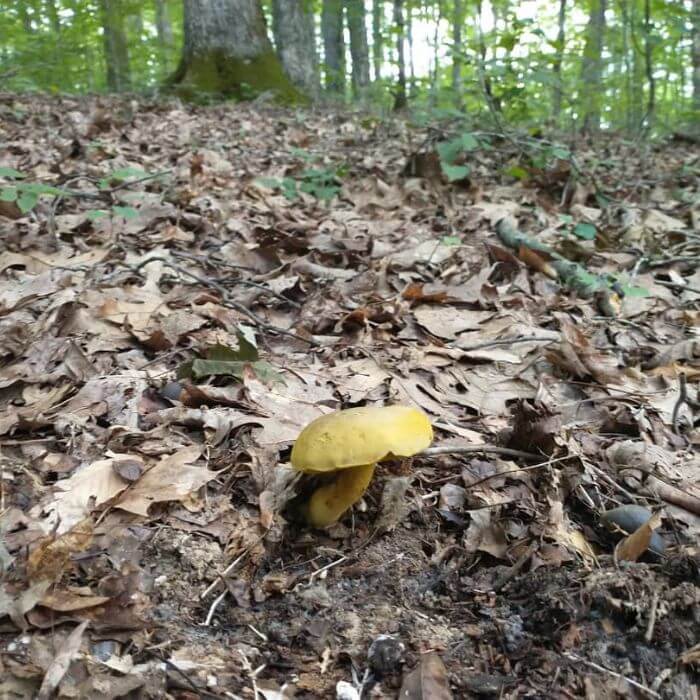
source: funeral_bell
Retiboletus ornatipes is an edible fungus of the Badger State. It is a mycorrhizal fungus; meaning its relationship with its hosts is mutually beneficial.
Identification:
The stalk or stipe of Retiboletus ornatipes ranges in color from yellowish to brownish with age. Its surface is covered with a net-like pattern.
Broadly convex cap is also yellowish for young species and has a velvety texture. Older ornate-stalked boletes are brownish with orangish-brown pores underneath.
Additionally, their non-staining flesh is bright yellow. They are classified as bitter tasting mushrooms according to various field guides.
15. Dacrymyces Chrysospermus (Orange witch’s butter)
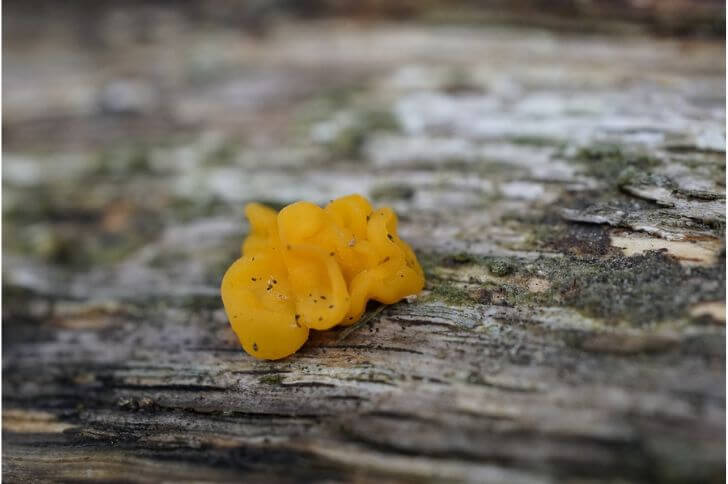
Remember the golden ear in this summary of yellow colored mushrooms? Dacrymyces chrysospermus are closely related to that fungus. They are also known as orange jelly spot or orange witch’s butter.
Identification:
It is an orange-yellow gelatinous cup fungus which can range from half an inch to one and a half inches in size. Orange witch’s butter stands out from other fungi due to its translucent outer walls, when viewed under full sunlight.
Its shape varies depending on the environment it is growing in but generally brain-shaped. Another way to identify this species is by examining the spores. When viewed under a microscope, they will appear smooth, oblong and pale yellow colored.
16. Sarcodon Imbricatus (Scaly Hedgehog)
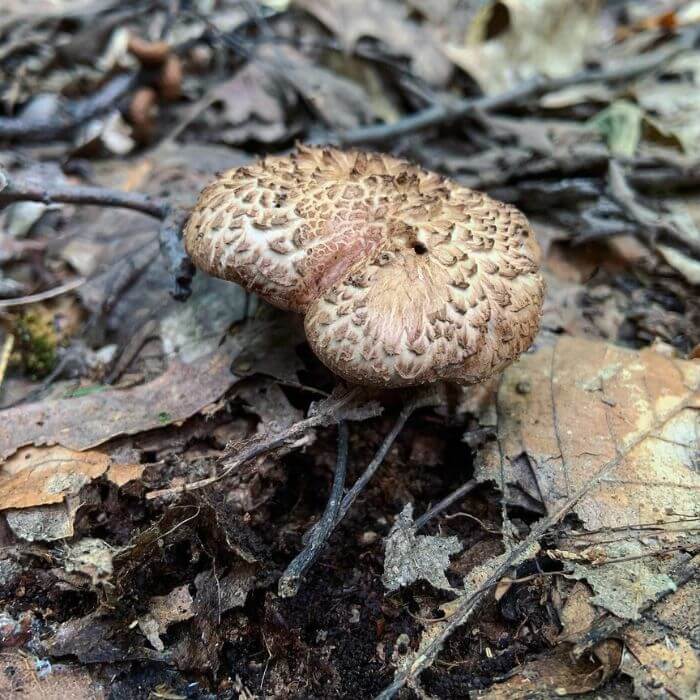
source: twosmallbirds
Another large edible mushroom of Wisconsin is the scaly hedgehog or sometimes called the shingled hedgehog. Scientific; sarcodon imbricatus.
Identification:
There are no crazy identifying features with this fungus. Scaly hedgehogs grow to about 12 inches but can be wider. The funnel-shaped cap is brownish with noticeable dark brown scales. Under the cap you’ll notice soft ‘teeth’ instead of the traditional gills.
Is the scaly hedgehog edible? Yes, in some countries younger species are dried and ground into flour.
17. Laccaria Amethystina (Amethyst Deceiver)
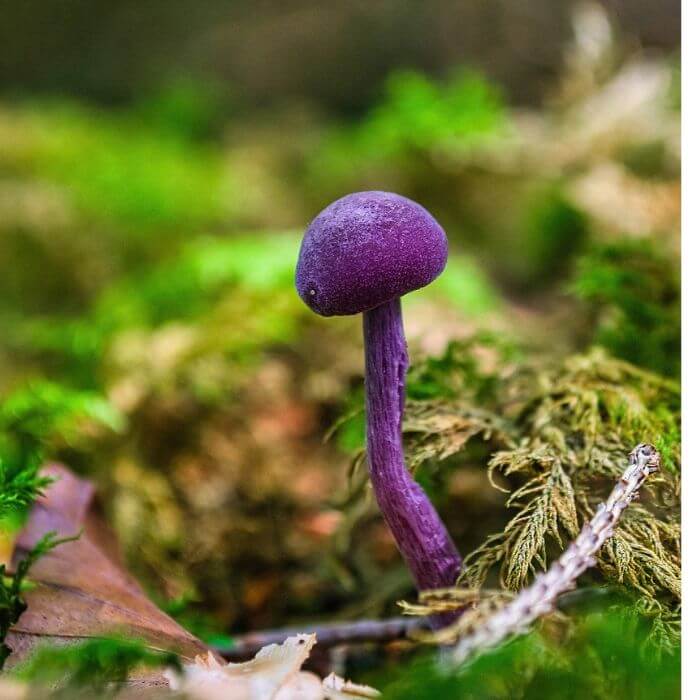
What are the purple mushrooms in Wisconsin? The laccaria amethystina, colloquially called amethyst deceiver, is a purple colored fungi that is common in the Badger State.
Identification:
Amethyst deceivers have some in the smallest caps in the fungi kingdom. Young laccarias have a convex cap that is less than an inch wide and a deep purple hue.
Older deceivers have a navel-like depression on their center, a flatter cap and changes to gray-brown.
Eventually, the cap turns upside, giving the mushroom a funnel-like shape. On its underside, this amethyst fungus has thick, widely spaced gills.
Is this laccaria edible? Though it has a deceitful name, the Amethyst deceiver is edible; most foragers prefer picking the caps only. However, it is not as tasty as other mushrooms like chanterelles.
18. Tylopilus Felleus (Bitter Bolete)
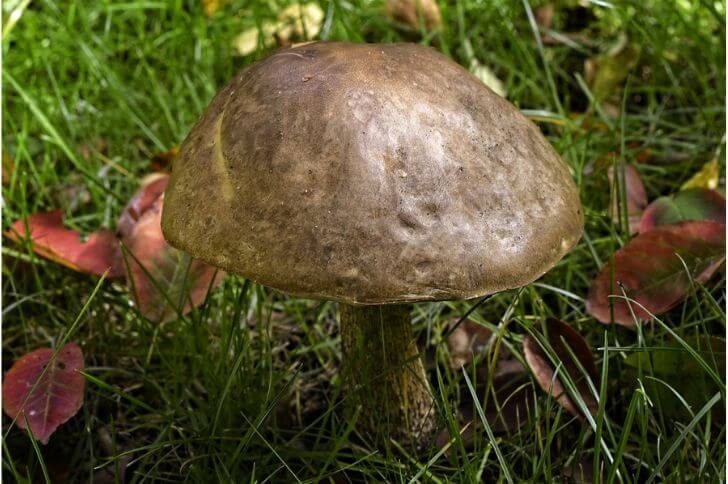
Now to a mushroom that lives up to its name! The bitter bolete or the tylopilus felleus typically pops up near deciduous trees such as oaks, beeches, and chestnuts. This mushroom has a distinctive appearance that can help with its identification.
Identification:
The cap of the Tylopilus felleus ranges in color from light gray to yellow to gray to brown. Its surface may be slightly hairy when young, but this disappears as it ages into a dry, bald texture. The stems are typically whitish-brown or tan in color.
Is the bitter bolete edible? Yes, but as the name suggests its very bitter making it unpalatable.
19. Lepista Nuda (Wood Blewit)
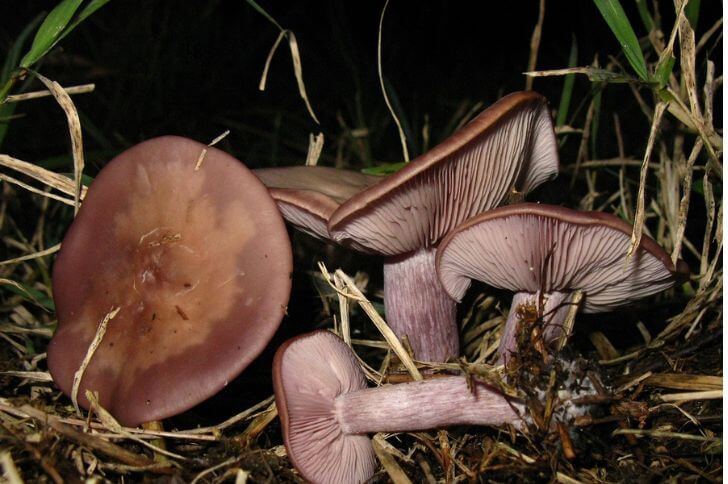
The wood blewit mushroom is one of the most sought after purple mushrooms. This species is prized for its unique hue, flavor and texture.
Identification:
The primary characteristics of wood blewits are its purple-gray cap, which can range from 1.9-5.9 inches wide when fully mature.
The gills underneath are a gorgeous lavender and eventually turn brown with maturity. The stipe can range from 1.9-3.9 inches long with a slightly bulbous base, often with a purplish hue near the base of it.
What can you do with wood blewits? Try sauteed blewits or a mushroom soup. You’ll love it!
20. Leotia Lubrica (Jelly Baby)
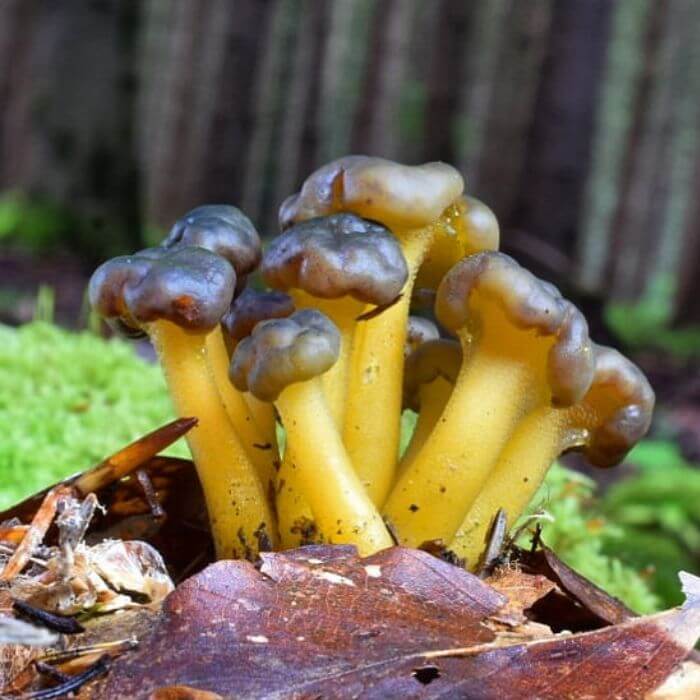
source: miladaprikosicka
Leotia lubrica, commonly known as jelly baby, is a species of fungi that belongs to the family Leotiaceae, which contains over 30 species.
Identification:
Jelly babies are small mushrooms that typically grow in clusters on deciduous wood or decaying logs. They have distinctive olive-greenish caps with soft rubbery stems.
The caps are usually between 1-2 inches in diameter and can sometimes be a bit sticky when wet. The stems range from 1-4 inches long and resemble rubber bands due to their elasticity. The underside of the cap is smooth with no gills. Jellybabies are inedible.
21. Laetiporus Sulphureus (Chicken of the Woods)
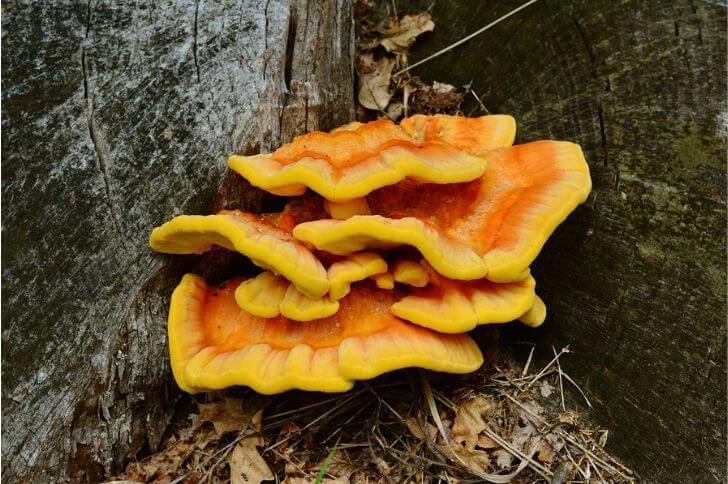
Laetiporus sulphureus, you may know it by its common name sulphur shelf or chicken of the woods mushroom, has made a name for itself among mushroom hunters.
Identification:
The best way to identify Laetiporus sulphureus is by its distinct features. The top layer of the mushrooms are often glossy with an orange or yellow hue that darkens over time.
Its shape is usually fan-like with wavy edges and it typically grows up to about 12 inches in diameter. When broken open, the flesh inside should be firm but spongy with white tubes on the underside of each piece.
22. Entoloma Abortivum (Shrimp of the Woods)
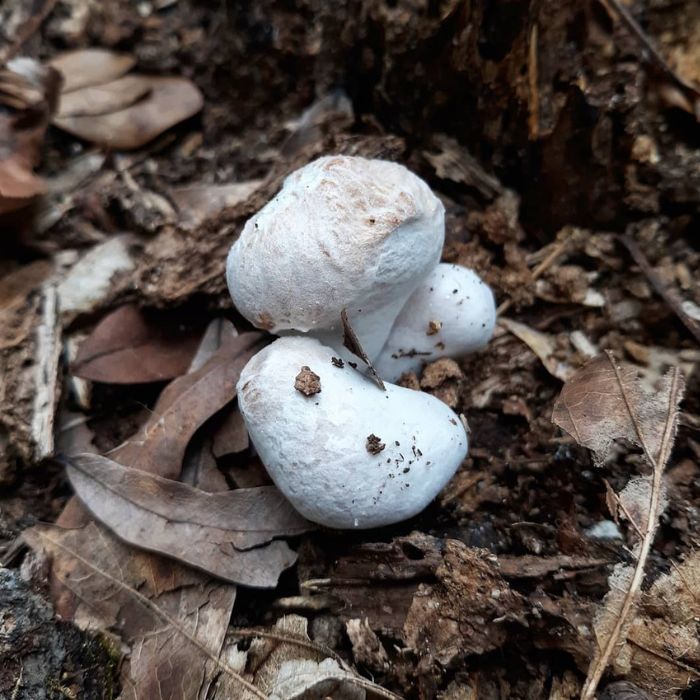
source: greyprimordialsoup
Shrimp of the woods or aborted entomola is a result of the honeys above parasitizing on a small fungi known as entoloma.
Identification:
This Wisconsin fungus has a popcorn-like cap. With its uneven surface, the cap ranges from 1-4 inches and is whitish-brown. The gills are also variable – some specimens have adnexed gills while others have decurrent gills.
They are also grayish becoming pinkish with age. Unlike entolomas, shrimp of the woods are edible and take on the texture of honey mushrooms; strongly mealy.
23. Ganoderma Tsugae (Hemlock Varnish Shelf)
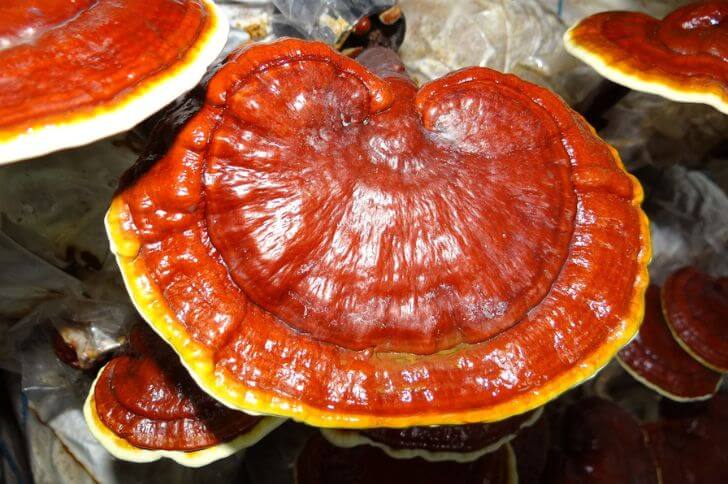
Ganoderma tsugae is recognizable by its distinctively shaped conks or fruiting bodies.
Identification:
Also known as hemlock varnish shelf, the ganoderma tsugae can be identified through a variety of characteristics, including its bright white pores on the underside of the conk and its reddish brown color on top. Its unique fan-shape also helps distinguish it from other fungi.
What is the ganoderma tsugae used for? Though inedible due to its tough texture, this polypore has for centuries been dried and used in teas.
24. Cerioporus Squamosus (Dryad’s Saddle)
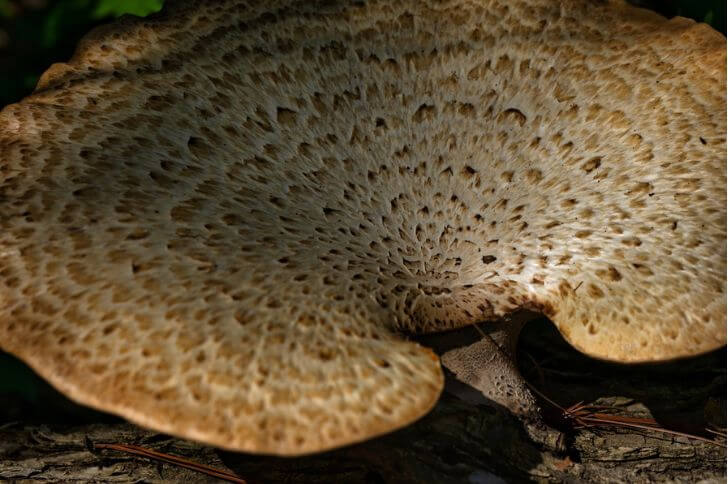
Cerioporus squamosus, also called dryad’s saddle or pheasant’s polypore, is an edible fungus
Identification:
This mushroom has a unique appearance that can easily be identified by anyone who loves to forage for wild mushrooms. The cap of Cerioporus squamosus is typically yellow-brown and scaly.
Its underside has a white pore surface. The thick stalk of this mushroom ranges in color from white to tan.
FAQs
What mushrooms are valuable in Wisconsin?
Morels. From March to May morels emerge in Wisconsin. These highly sought after mushrooms grow on the ground and are prized for their rich smoky flavor.
What are big white mushrooms in Wisconsin?
Giant Puffball. Calvatia Gigantea can grow to immense sizes, sometimes reaching up to 12 inches in diameter. The size of Calvatia Gigantea mushrooms depends on numerous environmental factors including the amount of sunlight they receive, soil moisture levels, temperature range, and nutrient availability.
What is the red top mushroom in Wisconsin?
Fly Agaric are red-capped mushrooms of Wisconsin. The red caps have whitish warts that disappear with age.
source:
Hi There,
My name is Jenny. I’m the Chief Editor at Try Green Recipes and besides making yummy and healthy foods for my kids, grandkids, and friends. I’m new to the blogging world but I believe what I have to share is unique and will bring joy to your home. If you are adventurous and want try something tasty, let’s get started.

